高二英语阅读理解强化训练附解析Day 1
高二英语阅读理解专项训练100(附答案)含解析
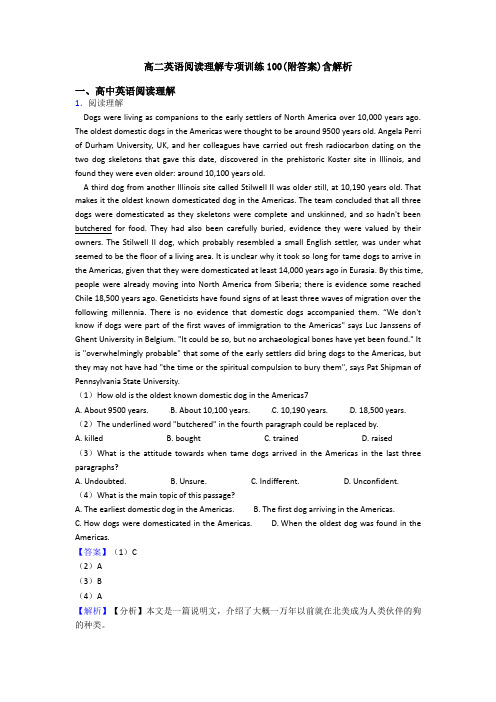
高二英语阅读理解专项训练100(附答案)含解析一、高中英语阅读理解1.阅读理解Dogs were living as companions to the early settlers of North America over 10,000 years ago. The oldest domestic dogs in the Americas were thought to be around 9500 years old. Angela Perri of Durham University, UK, and her colleagues have carried out fresh radiocarbon dating on the two dog skeletons that gave this date, discovered in the prehistoric Koster site in Illinois, and found they were even older: around 10,100 years old.A third dog from another Illinois site called Stilwell II was older still, at 10,190 years old. That makes it the oldest known domesticated dog in the Americas. The team concluded that all three dogs were domesticated as they skeletons were complete and unskinned, and so hadn't been butchered for food. They had also been carefully buried, evidence they were valued by their owners. The Stilwell II dog, which probably resembled a small English settler, was under what seemed to be the floor of a living area. It is unclear why it took so long for tame dogs to arrive in the Americas, given that they were domesticated at least 14,000 years ago in Eurasia. By this time, people were already moving into North America from Siberia; there is evidence some reached Chile 18,500 years ago. Geneticists have found signs of at least three waves of migration over the following millennia. There is no evidence that domestic dogs accompanied them. “We don't know if dogs were part of the first waves of immigration to the Americas" says Luc Janssens of Ghent University in Belgium. "It could be so, but no archaeological bones have yet been found." It is "overwhelmingly probable" that some of the early settlers did bring dogs to the Americas, but they may not have had "the time or the spiritual compulsion to bury them", says Pat Shipman of Pennsylvania State University.(1)How old is the oldest known domestic dog in the Americas7A. About 9500 years.B. About 10,100 years.C. 10,190 years.D. 18,500 years.(2)The underlined word "butchered" in the fourth paragraph could be replaced by.A. killedB. boughtC. trainedD. raised(3)What is the attitude towards when tame dogs arrived in the Americas in the last three paragraphs?A. Undoubted.B. Unsure.C. Indifferent.D. Unconfident.(4)What is the main topic of this passage?A. The earliest domestic dog in the Americas.B. The first dog arriving in the Americas.C. How dogs were domesticated in the Americas.D. When the oldest dog was found in the Americas.【答案】(1)C(2)A(3)B(4)A【解析】【分析】本文是一篇说明文,介绍了大概一万年以前就在北美成为人类伙伴的狗的种类。
(英语)高二英语阅读理解专项训练及答案及解析
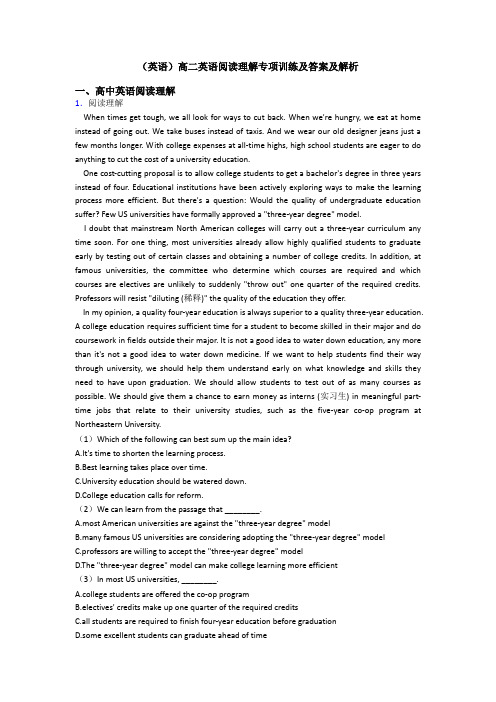
(英语)高二英语阅读理解专项训练及答案及解析一、高中英语阅读理解1.阅读理解When times get tough, we all look for ways to cut back. When we're hungry, we eat at home instead of going out. We take buses instead of taxis. And we wear our old designer jeans just a few months longer. With college expenses at all-time highs, high school students are eager to do anything to cut the cost of a university education.One cost-cutting proposal is to allow college students to get a bachelor's degree in three years instead of four. Educational institutions have been actively exploring ways to make the learning process more efficient. But there's a question: Would the quality of undergraduate education suffer? Few US universities have formally approved a "three-year degree" model.I doubt that mainstream North American colleges will carry out a three-year curriculum any time soon. For one thing, most universities already allow highly qualified students to graduate early by testing out of certain classes and obtaining a number of college credits. In addition, at famous universities, the committee who determine which courses are required and which courses are electives are unlikely to suddenly "throw out" one quarter of the required credits. Professors will resist "diluting (稀释)" the quality of the education they offer.In my opinion, a quality four-year education is always superior to a quality three-year education.A college education requires sufficient time for a student to become skilled in their major and do coursework in fields outside their major. It is not a good idea to water down education, any more than it's not a good idea to water down medicine. If we want to help students find their way through university, we should help them understand early on what knowledge and skills they need to have upon graduation. We should allow students to test out of as many courses as possible. We should give them a chance to earn money as interns (实习生) in meaningful part-time jobs that relate to their university studies, such as the five-year co-op program at Northeastern University.(1)Which of the following can best sum up the main idea?A.It's time to shorten the learning process.B.Best learning takes place over time.C.University education should be watered down.D.College education calls for reform.(2)We can learn from the passage that ________.A.most American universities are against the "three-year degree" modelB.many famous US universities are considering adopting the "three-year degree" modelC.professors are willing to accept the "three-year degree" modelD.The "three-year degree" model can make college learning more efficient(3)In most US universities, ________.A.college students are offered the co-op programB.electives' credits make up one quarter of the required creditsC.all students are required to finish four-year education before graduationD.some excellent students can graduate ahead of time(4)We can infer that________.A.the author is a college professor exploring ways to make learning more efficientB.the author thinks the cost of a university education is too high for people to affordC.the author considers the university education quality very importantD.the author pays special attention to the all-round development of college students【答案】(1)B(2)A(3)D(4)C【解析】【分析】本文是一篇议论文,作者认为把大学四年的学制缩短为三年不是一个好主意,保证足够的时间才能保证大学教育的质量。
(完整word版)高二英语阅读理解专项强化训练(新人教版)_试题
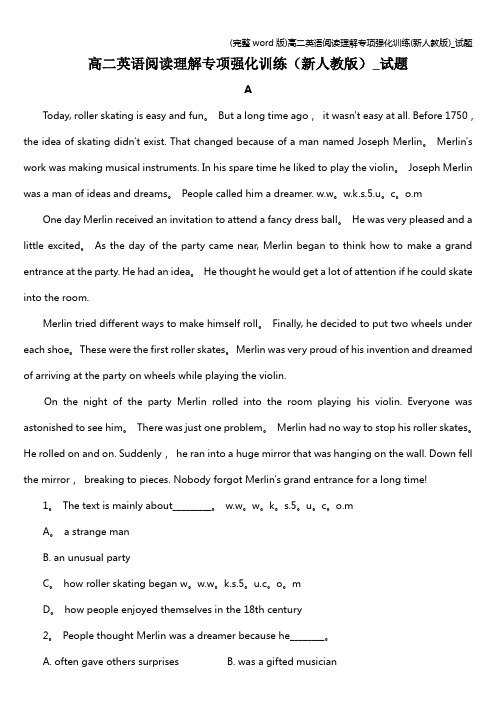
高二英语阅读理解专项强化训练(新人教版)_试题AToday, roller skating is easy and fun。
But a long time ago,it wasn't easy at all. Before 1750,the idea of skating didn't exist. That changed because of a man named Joseph Merlin。
Merlin's work was making musical instruments. In his spare time he liked to play the violin。
Joseph Merlin was a man of ideas and dreams。
People called him a dreamer. w.w。
w.k.s.5.u。
c。
o.m One day Merlin received an invitation to attend a fancy dress ball。
He was very pleased and a little excited。
As the day of the party came near, Merlin began to think how to make a grand entrance at the party. He had an idea。
He thought he would get a lot of attention if he could skate into the room.Merlin tried different ways to make himself roll。
Finally, he decided to put two wheels under each shoe。
These were the first roller skates。
高二英语阅读理解提高练习题及答案
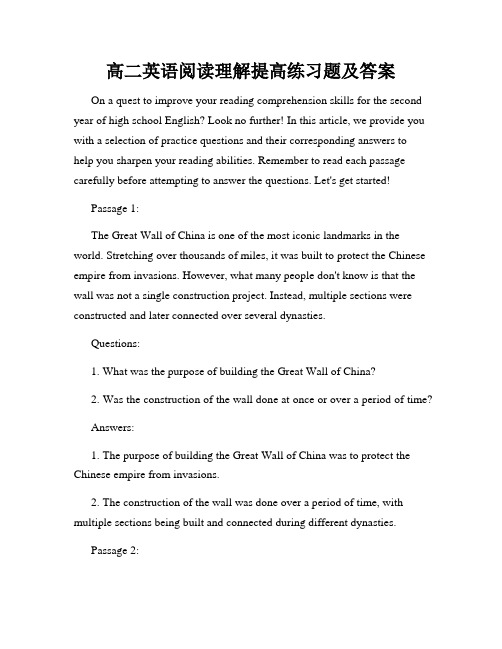
高二英语阅读理解提高练习题及答案On a quest to improve your reading comprehension skills for the second year of high school English? Look no further! In this article, we provide you with a selection of practice questions and their corresponding answers to help you sharpen your reading abilities. Remember to read each passage carefully before attempting to answer the questions. Let's get started!Passage 1:The Great Wall of China is one of the most iconic landmarks in the world. Stretching over thousands of miles, it was built to protect the Chinese empire from invasions. However, what many people don't know is that the wall was not a single construction project. Instead, multiple sections were constructed and later connected over several dynasties.Questions:1. What was the purpose of building the Great Wall of China?2. Was the construction of the wall done at once or over a period of time?Answers:1. The purpose of building the Great Wall of China was to protect the Chinese empire from invasions.2. The construction of the wall was done over a period of time, with multiple sections being built and connected during different dynasties.Passage 2:While honeybees are often associated with honey production, their role in pollination is even more vital. Bees are responsible for pollinating a vast number of plant species, including a significant portion of the world's food crops. Their declining population due to habitat loss and pesticide use poses a serious threat to ecosystems and global food security.Questions:1. Besides producing honey, what is the other important role of honeybees?2. What are the factors contributing to the declining population of honeybees?Answers:1. The other important role of honeybees is pollination, especially of food crops and various plant species.2. The declining population of honeybees is primarily caused by habitat loss and pesticide use.Passage 3:In recent years, there has been a growing trend towards remote work or telecommuting. This work arrangement allows employees to work from locations outside of a traditional office, often utilizing digital tools and communication platforms. While it offers flexibility and potential cost savings for both employers and employees, it also presents challenges in terms of collaboration and work-life balance.Questions:1. What is remote work or telecommuting?2. What are some advantages and disadvantages of remote work?Answers:1. Remote work or telecommuting refers to the practice of working outside of a traditional office, usually with the help of digital tools and communication platforms.2. The advantages of remote work include flexibility and potential cost savings, while the disadvantages include challenges in collaboration and work-life balance.By practicing these comprehension exercises regularly, you can improve your reading skills and become more confident in tackling English texts. Remember to pay attention to the details in the passages and choose the most accurate answer based on the information provided. Happy reading!。
高二英语阅读强化题附参考答案

高二英语阅读强化题附参考答案高二英语阅读强化题(一)1. A。
由文中第1句 Holidaymakers who are bored withbaking beaches and overheated hotel rooms head fora big igloo. (那些对在沙滩上晒太阳或对过热的旅店房间感到厌倦的度假人现在去雪屋度假)可以推断人们总是喜欢新鲜事物,应选 A。
2. B。
这道题考查考生的思维能力和生活常识。
既然是雪屋,总归是要融化的,所以第二段第一句话 In two weekstime Bergqvists ice creation will be nothing more than a pool of water 是对 soon the fun will beover 的诠释。
3. B。
文中第三段提及"6个工人花了8周时间将1000吨雪堆在木头基础上;当这些雪冻结之后,再将这里的基础移走",可见应先准备木头搭建的基础。
4. D。
由文中第四段第一句话 After their stay, all visitors receive a survival certificate recordingtheir success.(所有的来访者在离开之前都可得到一张记载他们在此生存成功的证书)。
高二英语阅读强化题答案The popularity of the igloo is beyond doubt: it is now attracting tourists from all over theworld. At least 800 people have stayed at the igloo this season even though there are only 10rooms. "You can get a lot of people in," explains Bergqvist. "The beds are three meters wide bytwo meters long, and can fit at least four at one time."1. Bergqvist designed and built the worlds first igloo hotel because ________.A. he believed people would enjoy trying something newB. he wanted to make a name for the small townC. an art exhibition was about to openD. more hotel rooms were needed2. When the writer says "the fun will be over," he refers to the fact that ________.A. hotel guests will be frightened at thought of the hard testB. Bergqvists hotel will soon become a pool of waterC. holidaymakers will soon get tired of the big iglooD. a bigger igloo will replace the present one3. according to the text, the first thing to do in building an igloo is ________.A. to gather a pool of waterB. to prepare a wooden baseC. to cover the ground with iceD. to pile a large amount of snow4. When guests leave the igloo hotel they will receive a paper stating that ________.A. they have visited LaplandB. They have had an ice-snow holidayC. they have had great fun sleeping on iceD. they have had a taste of adventure高二英语阅读强化题(二)When I was a boy, I belonged to the Boy Scouts so Iused to go camping every summer, and oncesomething happened which I have never been able toexplain.We were camping in a place above a river. Afterarriving, we all rushed down to the river and had aswim. Standing by the river, we noticed that it wassurrounded(环绕) by cliffs(悬崖). If someone wanted to reach the river at this point, he had towalk past our camp.Several days later, the scoutmaster had to be away for a day. That afternoon, we had supperearly. We were sitting round the fire, eating and talking, when a man walked past and wentdown towards the river. We all felt that this man looked very strange, but, because each of uswas afraid of looking very stupid, no one said anything.We ate rather slowly, taking as long as possible. After finishing, we collected our plates togetherso that we could take them to the river where we always washed them. But no one movedtowards the rivere stood looking at each other ashamed. Then all shouting at once, we begantalking about the man who had walked past us. We agreed how strange he looked and wewondered what he could be doing by the river. We knew that he could only return by passingthrough our camp.An hour passed. Then one of the boys suggested we should creep(悄悄移动) down by the river sothat we could see what the man was doing. Moving very slowly and keeping in the shadow, wecrept down towards the bank. One boy climbed a tree so that he could see everything clearly.He called to us that there was no one there, so we ran down to the bank, looking everywherecarefully. We could not understand where the man had gone.When it got dark, we went back to our camp feeling bewildered. We told the scoutmaster whathad happened in the evening. Smiling, he doubted that we had seen the man, but finallysuggested we go and look again. We did, but there was no one there.Many years have passed, but I still remember it as if it were yesterday. What did we see? I donot know.1. The writer in the text mainly tells us _________.A. the story of his childhoodB. a strange camping experienceC. about a stranger by the riverD. about a good place for camping2. Why did the boys eat their supper slowly?A. They wanted to delay going to the river bank.B. They were sitting for their scoutmaster.C. They had a supper earlier than usual.D. They were taking while eating.3. The word “Bewildered” in the text probably means _________.A. ashamedB. nervousC. unable to understandD. eager to know something4. When he heard what had happened, the scoutmaster _________.A. realized who the man wasB. started to worry about the manC. went back to look for the manD. felt it hard to believe the boys5. The writer still remembers the event because ________.A. the boys acted foolishlyB. the camping place is beautifulC. there has been no explanation for the eventD. he particularly enjoyed his camping that summer.。
高二英语阅读理解专项训练及答案.doc
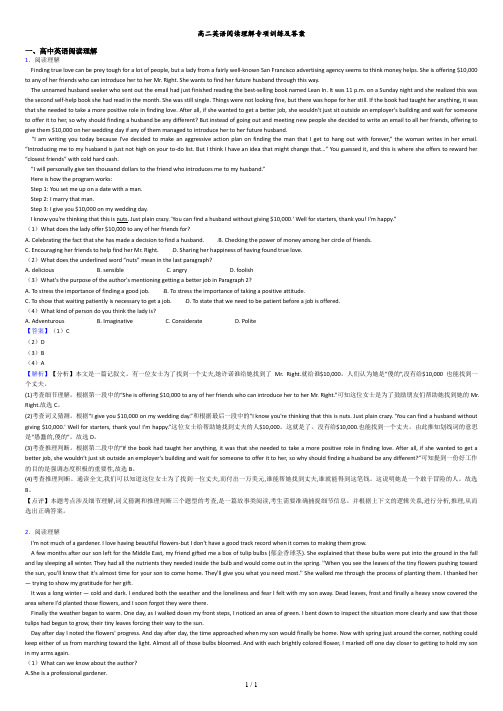
高二英语阅读理解专项训练及答案一、高中英语阅读理解1.阅读理解Finding true love can be prey tough for a lot of people, but a lady from a fairly well-known San Francisco advertising agency seems to think money helps. She is offering $10,000 to any of her friends who can introduce her to her Mr. Right. She wants to find her future husband through this way.The unnamed husband seeker who sent out the email had just finished reading the best-selling book named Lean In. It was 11 p.m. on a Sunday night and she realized this was the second self-help book she had read in the month. She was still single. Things were not looking fine, but there was hope for her still. If the book had taught her anything, it was that she needed to take a more positive role in finding love. After all, if she wanted to get a better job, she wouldn't just sit outside an employer's building and wait for someone to offer it to her, so why should finding a husband be any different? But instead of going out and meeting new people she decided to write an email to all her friends, offering to give them $10,000 on her wedding day if any of them managed to introduce her to her future husband.“I am writing you today because I've decided to make an aggressive action plan on finding the man that I get to hang out with forever,” the woman writes in her email. “Introducing me to my husband is just not high on your to-do list. But I think I have an idea that might change that…” You guessed it, and this is where she offers to reward her “closest friends” with cold hard cash.“I will personally give ten thousand dollars to the friend who introduces me to my husband.”Here is how the program works:Step 1: You set me up on a date with a man.Step 2: I marry that man.Step 3: I give you $10,000 on my wedding day.I know you're thinking that this is nuts. Just plain crazy. 'You can find a husband without giving $10,000.' Well for starters, thank you! I'm happy.”(1)What does the lady offer $10,000 to any of her friends for?A. Celebrating the fact that she has made a decision to find a husband.B. Checking the power of money among her circle of friends.C. Encouraging her friends to help find her Mr. Right.D. Sharing her happiness of having found true love.(2)What does t he underlined word “nuts” mean in the last paragraph?A. deliciousB. sensibleC. angryD. foolish(3)What's the purpose of the author's mentioning getting a better job in Paragraph 2?A. To stress the importance of finding a good job.B. To stress the importance of taking a positive attitude.C. To show that waiting patiently is necessary to get a job.D. To state that we need to be patient before a job is offered.(4)What kind of person do you think the lady is?A. AdventurousB. ImaginativeC. ConsiderateD. Polite【答案】(1)C(2)D(3)B(4)A【解析】【分析】本文是一篇记叙文。
高二英语阅读理解专项训练及答案含解析
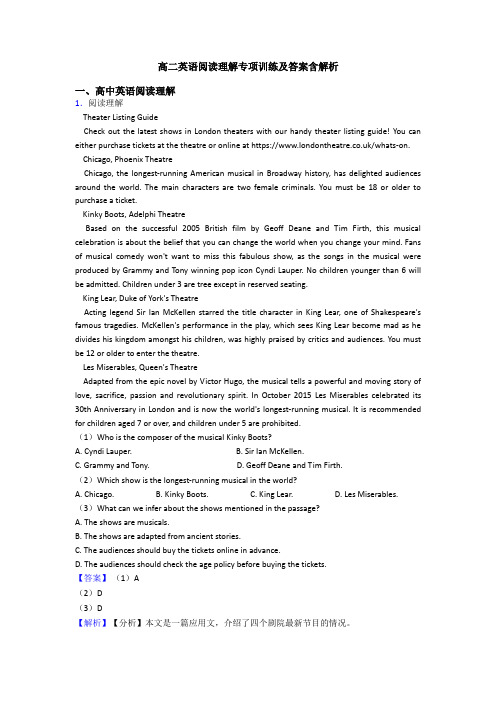
高二英语阅读理解专项训练及答案含解析一、高中英语阅读理解1.阅读理解Theater Listing GuideCheck out the latest shows in London theaters with our handy theater listing guide! You can either purchase tickets at the theatre or online at https:///whats-on.Chicago, Phoenix TheatreChicago, the longest-running American musical in Broadway history, has delighted audiences around the world. The main characters are two female criminals. You must be 18 or older to purchase a ticket.Kinky Boots, Adelphi TheatreBased on the successful 2005 British film by Geoff Deane and Tim Firth, this musical celebration is about the belief that you can change the world when you change your mind. Fans of musical comedy won't want to miss this fabulous show, as the songs in the musical were produced by Grammy and Tony winning pop icon Cyndi Lauper. No children younger than 6 will be admitted. Children under 3 are tree except in reserved seating.King Lear, Duke of York's TheatreActing legend Sir Ian McKellen starred the title character in King Lear, one of Shakespeare's famous tragedies. McKellen's performance in the play, which sees King Lear become mad as he divides his kingdom amongst his children, was highly praised by critics and audiences. You must be 12 or older to enter the theatre.Les Miserables, Queen's TheatreAdapted from the epic novel by Victor Hugo, the musical tells a powerful and moving story of love, sacrifice, passion and revolutionary spirit. In October 2015 Les Miserables celebrated its 30th Anniversary in London and is now the world's longest-running musical. It is recommended for children aged 7 or over, and children under 5 are prohibited.(1)Who is the composer of the musical Kinky Boots?A. Cyndi Lauper.B. Sir Ian McKellen.C. Grammy and Tony.D. Geoff Deane and Tim Firth.(2)Which show is the longest-running musical in the world?A. Chicago.B. Kinky Boots.C. King Lear.D. Les Miserables.(3)What can we infer about the shows mentioned in the passage?A. The shows are musicals.B. The shows are adapted from ancient stories.C. The audiences should buy the tickets online in advance.D. The audiences should check the age policy before buying the tickets.【答案】(1)A(2)D(3)D【解析】【分析】本文是一篇应用文,介绍了四个剧院最新节目的情况。
(英语)高二英语阅读理解专项训练100(附答案)

(英语)高二英语阅读理解专项训练100(附答案)一、高中英语阅读理解1.阅读理解One day a very skilled artist met a beautiful woman who immediately became the object of his affections. As he observed her and spoke with her, he admired her more and more. He showered her with kindness and words of praise until she consented to be his wife.Not long after they were married, however, the beautiful woman found out that she was more the object of his artistic interest than of his affections. When he admired her classic beauty, it was as though he were standing in front of a work of art rather than in front of a human being to whom he had pledged his love and promised his life. And soon he expressed his great desire to put her rare beauty on canvas.“Please sit for me in the workroom,” he pleaded, “and I will make your beauty permanent. The work will be my masterpiece!”She was humble and patient as well as flattered by his words, so she said, “Yes, my love. I will be happy to sit for you.” So the beautiful, young wife of the artist sa t meekly for hours in his studio, not complaining. Day after day she sat patiently, smiling as she posed, because she loved him and because she hoped that he would see her love in her smile and obedience. She sometimes wanted to call out to him, “Please lo ve me and want me as a person rather than as an object!” But instead, she spoke nothing but words which pleased him.At length, as the labor drew to close, the painter became wilder in his passion for his work. He only rarely turned his eyes from the canvas to look at his wife. As he stood there gazing at his beautiful work of art, he cried with a loud voice, “This is indeed life itself!” Then he turned to his beloved and saw that she was dead!(1)In what way did the artist express his appreciation of his wife's rare beauty?A. He put her classic beauty on canvas.B. He promised to marry her.C. He centered his deep affection on her.D. He pledged his love and promised his life to her.(2)What can be inferred from the story?A. The artist loved his work more than his wife.B. The artist didn't really understand what is beauty.C. The wife was fooled to sacrifice for his art creation.D. The wife loved his painting more than herself.(3)What did the artist mean by saying “This is indeed life itself!”?A. He appreciated his life of painting.B. He was grateful to his wife.C. His work was more true to life than life itself.D. His effort was really worth it.(4)What would be the best title for this passage?A. A Well-matched CoupleB. A Devoted ArtistC. A Rare MasterpieceD. A Stupid Wife【答案】(1)A(2)A(3)C(4)B【解析】【分析】本文是一篇记叙文,有一位技艺超群的画家遇到一位美丽的女士,顿生爱意。
(英语)高二英语阅读理解专项训练及答案及解析.docx
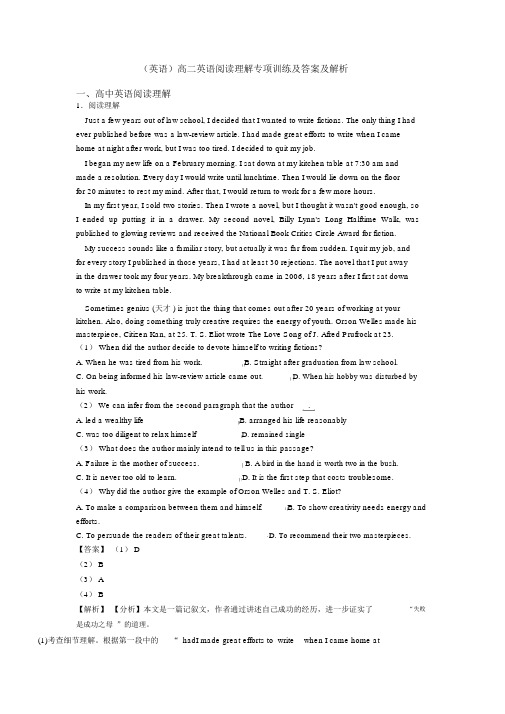
(英语)高二英语阅读理解专项训练及答案及解析一、高中英语阅读理解1.阅读理解Just a few years out of law school, I decided that I wanted to write fictions. The only thing I had ever published before was a law-review article. I had made great efforts to write when I camehome at night after work, but I was too tired. I decided to quit my job.I began my new life on a February morning. I sat down at my kitchen table at 7:30 am andmade a resolution. Every day I would write until lunchtime. Then I would lie down on the floorfor 20 minutes to rest my mind. After that, I would return to work for a few more hours.In my first year, I sold two stories. Then I wrote a novel, but I thought it wasn't good enough, soI ended up putting it in a drawer. My second novel, Billy Lynn's Long Halftime Walk, waspublished to glowing reviews and received the National Book Critics Circle Award for fiction.My success sounds like a familiar story, but actually it was far from sudden. I quit my job, and for every story I published in those years, I had at least 30 rejections. The novel that I put awayin the drawer took my four years. My breakthrough came in 2006, 18 years after I first sat downto write at my kitchen table.Sometimes genius (天才 ) is just the thing that comes out after 20 years of working at your kitchen. Also, doing something truly creative requires the energy of youth. Orson Welles made hismasterpiece, Citizen Kan, at 25. T. S. Eliot wrote The Love Song of J. Afred Prufrock at 23.(1) When did the author decide to devote himself to writing fictions?A. When he was tired from his work.B. Straight after graduation from law school.C. On being informed his law-review article came out.D. When his hobby was disturbed byhis work.(2) We can infer from the second paragraph that the author.A. led a wealthy lifeB. arranged his life reasonablyC. was too diligent to relax himselfD. remained single(3) What does the author mainly intend to tell us in this passage?A. Failure is the mother of success.B. A bird in the hand is worth two in the bush.C. It is never too old to learn.D. It is the first step that costs troublesome.(4) Why did the author give the example of Orson Welles and T. S. Eliot?A. To make a comparison between them and himself.B. To show creativity needs energy andefforts.C. To persuade the readers of their great talents.D. To recommend their two masterpieces.【答案】(1) D(2) B(3) A(4) B【解析】【分析】本文是一篇记叙文,作者通过讲述自己成功的经历,进一步证实了“失败是成功之母”的道理。
(英语)高二必备英语阅读理解技巧全解及练习题(含答案)含解析
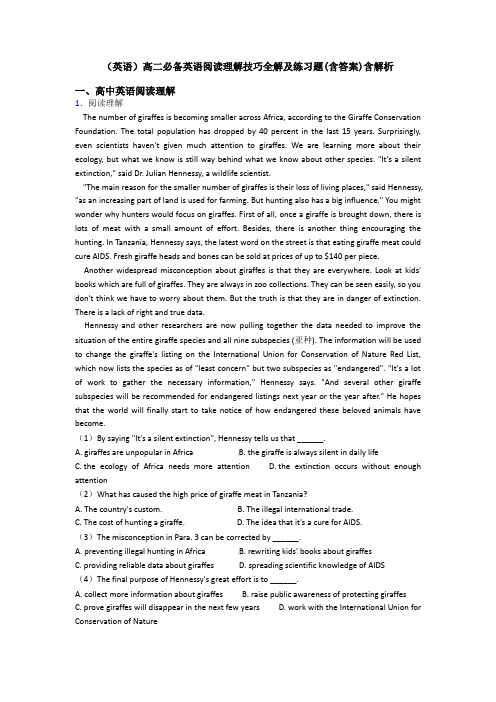
(英语)高二必备英语阅读理解技巧全解及练习题(含答案)含解析一、高中英语阅读理解1.阅读理解The number of giraffes is becoming smaller across Africa, according to the Giraffe Conservation Foundation. The total population has dropped by 40 percent in the last 15 years. Surprisingly, even scientists haven't given much attention to giraffes. We are learning more about their ecology, but what we know is still way behind what we know about other species. "It's a silent extinction," said Dr. Julian Hennessy, a wildlife scientist."The main reason for the smaller number of giraffes is their loss of living places," said Hennessy, "as an increasing part of land is used for farming. But hunting also has a big influence." You might wonder why hunters would focus on giraffes. First of all, once a giraffe is brought down, there is lots of meat with a small amount of effort. Besides, there is another thing encouraging the hunting. In Tanzania, Hennessy says, the latest word on the street is that eating giraffe meat could cure AIDS. Fresh giraffe heads and bones can be sold at prices of up to $140 per piece.Another widespread misconception about giraffes is that they are everywhere. Look at kids' books which are full of giraffes. They are always in zoo collections. They can be seen easily, so you don't think we have to worry about them. But the truth is that they are in danger of extinction. There is a lack of right and true data.Hennessy and other researchers are now pulling together the data needed to improve the situation of the entire giraffe species and all nine subspecies (亚种). The information will be used to change the giraffe's listing on the International Union for Conservation of Nature Red List, which now lists the species as of "least concern" but two subspecies as "endangered". "It's a lot of work to gather the necessary information," Hennessy says. "And several other giraffe subspecies will be recommended for endangered listings next year or the year after." He hopes that the world will finally start to take notice of how endangered these beloved animals have become.(1)By saying "It's a silent extinction", Hennessy tells us that ______.A. giraffes are unpopular in AfricaB. the giraffe is always silent in daily lifeC. the ecology of Africa needs more attentionD. the extinction occurs without enough attention(2)What has caused the high price of giraffe meat in Tanzania?A. The country's custom.B. The illegal international trade.C. The cost of hunting a giraffe.D. The idea that it's a cure for AIDS.(3)The misconception in Para. 3 can be corrected by ______.A. preventing illegal hunting in AfricaB. rewriting kids' books about giraffesC. providing reliable data about giraffesD. spreading scientific knowledge of AIDS(4)The final purpose of Hennessy's great effort is to ______.A. collect more information about giraffesB. raise public awareness of protecting giraffesC. prove giraffes will disappear in the next few yearsD. work with the International Union for Conservation of Nature【答案】(1)D(2)D(3)C(4)B【解析】【分析】本文是一篇说明文,介绍了长颈鹿濒临灭绝的原因,并指出提供准确的数据,提高人们的保护意识至关重要。
高二英语阅读强化训练(含答案解析)
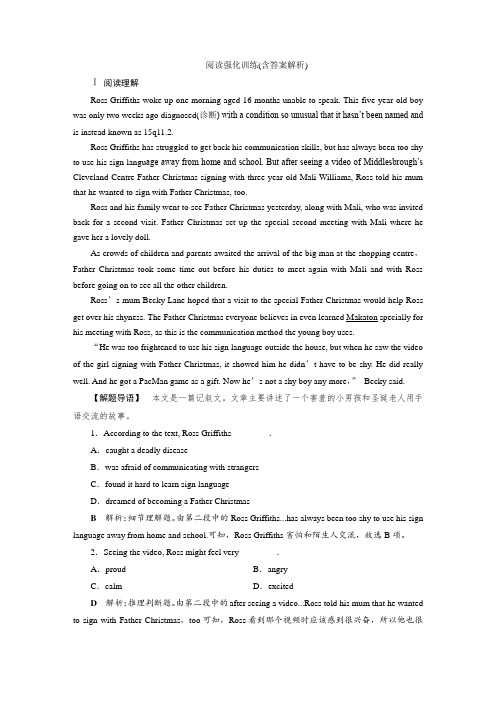
阅读强化训练(含答案解析)Ⅰ阅读理解Ross Griffiths woke up one morning aged 16 months unable to speak. This five-year-old boy was only two weeks ago diagnosed(诊断) with a condition so unusual that it hasn’t been named and is instead known as 15q11.2.Ross Griffiths has struggled to get back his communication skills, but has always been too shy to use his sign langu age away from home and school. But after seeing a video of Middlesbrough’s Cleveland Centre Father Christmas signing with three-year-old Mali Williams, Ross told his mum that he wanted to sign with Father Christmas, too.Ross and his family went to see Father Christmas yesterday, along with Mali, who was invited back for a second visit. Father Christmas set up the special second meeting with Mali where he gave her a lovely doll.As crowds of children and parents awaited the arrival of the big man at the shopping centre,Father Christmas took some time out before his duties to meet again with Mali and with Ross before going on to see all the other children.Ross’s mum Becky Lane hoped that a visit to the special Father Christmas would help Ross get over his shyness. The Father Christmas everyone believes in even learned Makaton specially for his meeting with Ross, as this is the communication method the young boy uses.“He was too frightened to use his sign language outside the house, but when he saw the video of the girl signing with Father Christmas, it showed him he didn’t have to be shy. He did really well. And he got a PacMan game as a gift. Now he’s not a shy boy any more,”Becky said.【解题导语】本文是一篇记叙文。
高二英语阅读理解专项训练及答案及解析
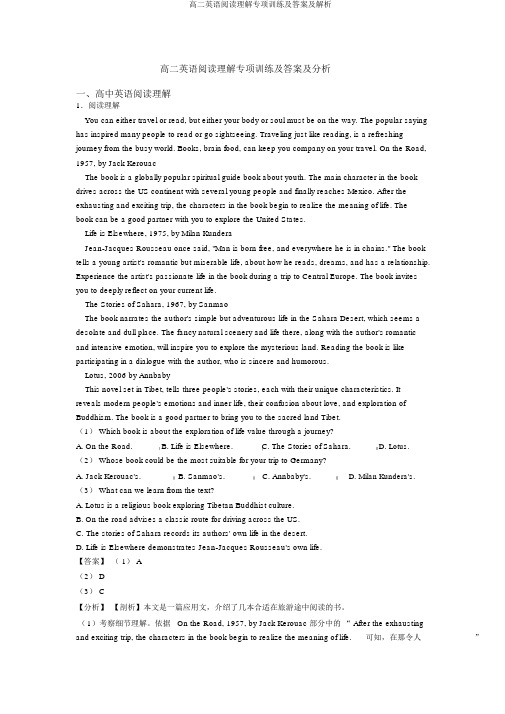
高二英语阅读理解专项训练及答案及分析一、高中英语阅读理解1.阅读理解You can either travel or read, but either your body or soul must be on the way. The popular sayinghas inspired many people to read or go sightseeing. Traveling just like reading, is a refreshingjourney from the busy world. Books, brain food, can keep you company on your travel. On the Road,1957, by Jack KerouacThe book is a globally popular spiritual guide book about youth. The main character in the bookdrives across the US continent with several young people and finally reaches Mexico. After theexhausting and exciting trip, the characters in the book begin to realize the meaning of life. Thebook can be a good partner with you to explore the United States.Life is Elsewhere, 1975, by Milan KunderaJean-Jacques Rousseau once said, "Man is born free, and everywhere he is in chains." The booktells a young artist's romantic but miserable life, about how he reads, dreams, and has a relationship.Experience the artist's passionate life in the book during a trip to Central Europe. The book invitesyou to deeply reflect on your current life.The Stories of Sahara, 1967, by SanmaoThe book narrates the author's simple but adventurous life in the Sahara Desert, which seems adesolate and dull place. The fancy natural scenery and life there, along with the author's romanticand intensive emotion, will inspire you to explore the mysterious land. Reading the book is likeparticipating in a dialogue with the author, who is sincere and humorous.Lotus, 2006 by AnnbabyThis novel set in Tibet, tells three people's stories, each with their unique characteristics. Itreveals modern people's emotions and inner life, their confusion about love, and exploration ofBuddhism. The book is a good partner to bring you to the sacred land Tibet.(1) Which book is about the exploration of life value through a journey?A. On the Road.B. Life is Elsewhere.C. The Stories of Sahara.D. Lotus.(2) Whose book could be the most suitable for your trip to Germany?A. Jack Kerouac's.B. Sanmao's.C. Annbaby's.D. Milan Kundera's.(3) What can we learn from the text?A. Lotus is a religious book exploring Tibetan Buddhist culture.B. On the road advises a classic route for driving across the US.C. The stories of Sahara records its authors' own life in the desert.D. Life is Elsewhere demonstrates Jean-Jacques Rousseau's own life.【答案】( 1) A(2) D(3) C【分析】【剖析】本文是一篇应用文,介绍了几本合适在旅游途中阅读的书。
高二英语阅读理解及答案解析
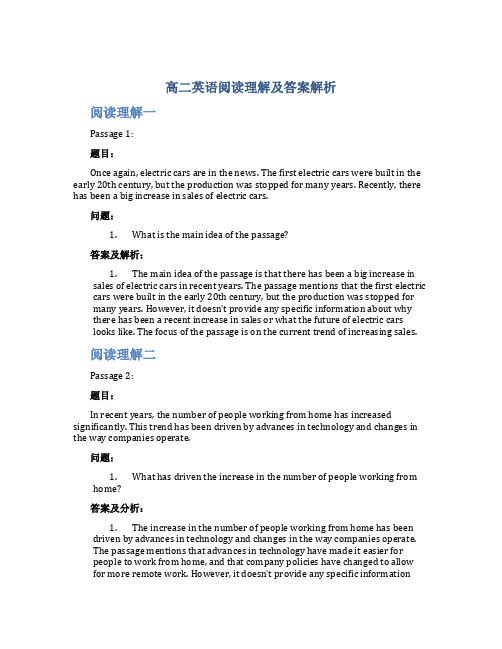
高二英语阅读理解及答案解析阅读理解一Passage 1:题目:Once again, electric cars are in the news. The first electric cars were built in the early 20th century, but the production was stopped for many years. Recently, there has been a big increase in sales of electric cars.问题:1.What is the main idea of the passage?答案及解析:1.The main idea of the passage is that there has been a big increase insales of electric cars in recent years. The passage mentions that the first electric cars were built in the early 20th century, but the production was stopped for many years. However, it doesn’t provide any specific information about why there has been a recent increase in sales or what the future of electric carslooks like. The focus of the passage is on the current trend of increasing sales.阅读理解二Passage 2:题目:In recent years, the number of people working from home has increased significantly. This trend has been driven by advances in technology and changes in the way companies operate.问题:1.What has driven the increase in the number of people working fromhome?答案及分析:1.The increase in the number of people working from home has beendriven by advances in technology and changes in the way companies operate.The passage mentions that advances in technology have made it easier forpeople to work from home, and that company policies have changed to allow for more remote work. However, it doesn’t provide any specific informationabout how many people are working from home or the benefits and challenges of remote work. The focus of the passage is on the factors driving the increase in remote work.阅读理解三Passage 3:题目:Climate change is a global issue that is affecting the planet in a variety of ways. Rising temperatures, extreme weather events, and melting ice caps are just a few of the consequences of climate change.问题:1.What are some of the consequences of climate change?答案及解析:1.Some of the consequences of climate change mentioned in the passageinclude rising temperatures, extreme weather events, and melting ice caps. The passage doesn’t provide any specific information about how theseconsequences are affecting the planet or what actions can be taken to mitigate climate change. The focus of the passage is on the variety of ways in whichclimate change is impacting the planet.。
高二英语阅读理解题20套带答案

高二英语阅读理解题20套带答案(第一部分)一、阅读理解题(共15小题,每小题2分,满分30分)Passage 1Text AOnce upon a time, there was a young man named Jack wholived in a small village. He was known for his laziness and always depended on his parents. One day, his father said to him, "Jack, you're old enough to work. I want you to go tothe city and find a job."One day, Jack saw an advertisement for a gardener in a wealthy family. He decided to give it a try. To his surprise,he was hired. The employer was an old man who loved plants.He taught Jack how to take care of the garden, and Jack gradually fell in love with the job.1. Why did Jack's father ask him to find a job in thecity?A. Because Jack was too lazy to work in the village.B. Because Jack was old enough to support himself.C. Because Jack's parents wanted him to get a good education.D. Because Jack wanted to live a better life in thecity.答案:BA. Because he had no skills and experience.B. Because he was too lazy to work.C. Because he was from a small village.D. Because he didn't have a college degree.答案:A高二英语阅读理解题20套带答案(第二部分)Passage 1(续)Text BJack was grateful for the opportunity and worked even harder. He turned the piece of land into a beautiful garden, attracting visitors from far and near. Jack's success inspired many young people in the village to learn a skill and work hard.3. What did the old man give Jack as a reward for his hard work?A. A lot of money.B. A piece of land.C. A new house.D. A gardening book.答案:B4. Why did Jack's success inspire the young people in the village?A. Because he became a famous gardener.B. Because he showed them the importance of hard work and skills.C. Because he made a lot of money.D. Because he moved to a big city.答案:BPassage 2Text AOne of the advantages is that it offers flexibility. Students can learn at their own pace and schedule their study time according to their needs. Additionally, online education allows students from different parts of the world to interact and learn from each other.On the other hand, online education has its drawbacks. Some students may find it difficult to stay motivated without facetoface interaction. Moreover, technical issues such as poor internet connection can disrupt the learning process.5. What is the main idea of the passage?A. Online education is better than traditional education.B. Online education has both advantages and disadvantages.D. Students prefer online education to traditional education.答案:B6. Which of the following is an advantage of online education?A. It is more expensive than traditional education.B. It requires students to attend classes at a fixed time.C. It allows students to learn at their own pace.D. It limits the interaction between students and teachers.答案:C高二英语阅读理解题20套带答案(第三部分)Passage 2(续)Text BMany parents are concerned about the impact of online education on their children's social skills. They worry that without the daily interaction with classmates, children might struggle to develop important social abilities. However, proponents of online education argue that it can actually enhance social skills connecting students with a more diverse group of peers.7. What is the main concern of parents regarding online education?A. The quality of education is lower than traditional education.C. Online education is too expensive.D. Their children might get addicted to the internet.答案:B8. What do proponents of online education believe?A. Online education is the only way for children to learn.B. Online education limits social interaction.C. Online education can improve social skills.D. Online education is suitable for all students.答案:CPassage 3Text AThe concept of a growth mindset has gained a lot of attention in recent years. A growth mindset is the belief that abilities and intelligence can be developed through dedication and hard work. People with a growth mindset are more likely to embrace challenges and persist in the face of setbacks.On the contrary, a fixed mindset is the belief that abilities and intelligence are static traits. Individuals with a fixed mindset often avoid challenges and give up easily when they encounter obstacles.9. What is the main difference between a growth mindset and a fixed mindset?A. A growth mindset believes in the power of hard work, while a fixed mindset does not.B. A growth mindset is only for successful people,while a fixed mindset is for everyone.C. A growth mindset focuses on innate talent, while a fixed mindset focuses on effort.D. A growth mindset avoids challenges, while a fixed mindset embraces them.答案:A10. Why are people with a growth mindset more likely to succeed?A. They are born with more talent.B. They never encounter any obstacles.C. They believe in their ability to improve andpersist through challenges.D. They have a fixed mindset.答案:C。
高二英语阅读理解专项训练及答案及解析
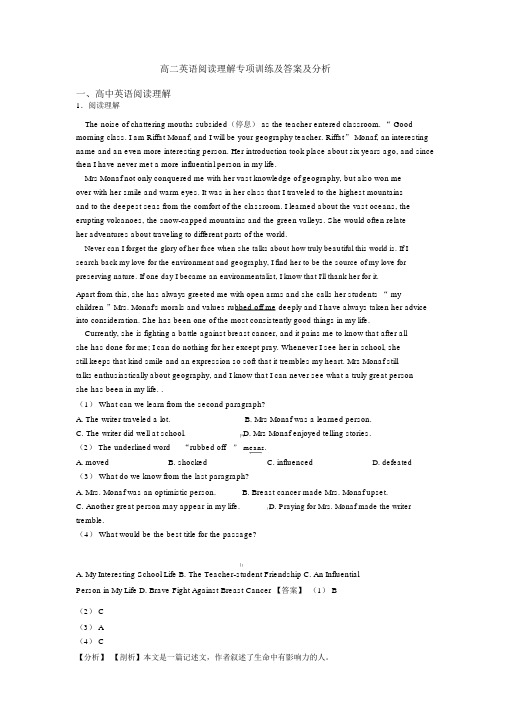
高二英语阅读理解专项训练及答案及分析一、高中英语阅读理解1.阅读理解The noise of chattering mouths subsided(停息) as the teacher entered classroom. “ Good morning class. I am Riffat Monaf, and I will be your geography teacher. Riffat” Monaf, an interesting name and an even more interesting person. Her introduction took place about six years ago, and since then I have never met a more influential person in my life.Mrs Monaf not only conquered me with her vast knowledge of geography, but also won meover with her smile and warm eyes. It was in her class that I traveled to the highest mountainsand to the deepest seas from the comfort of the classroom. I learned about the vast oceans, the erupting volcanoes, the snow-capped mountains and the green valleys. She would often relateher adventures about traveling to different parts of the world.Never can I forget the glory of her face when she talks about how truly beautiful this world is. If I search back my love for the environment and geography, I find her to be the source of my love for preserving nature. If one day I became an environmentalist, I know that I'll thank her for it.Apart from this, she has always greeted me with open arms and she calls her students “ my children ”Mrs. Monaf's morals and values rubbed off me deeply and I have always taken her advice into consideration. She has been one of the most consistently good things in my life.Currently, she is fighting a battle against breast cancer, and it pains me to know that after allshe has done for me; I can do nothing for her except pray. Whenever I see her in school, shestill keeps that kind smile and an expression so soft that it trembles my heart. Mrs Monaf stilltalks enthusiastically about geography, and I know that I can never see what a truly great personshe has been in my life. .(1) What can we learn from the second paragraph?A. The writer traveled a lot.B. Mrs Monaf was a learned person.C. The writer did well at school.D. Mrs Monaf enjoyed telling stories.(2) The underlined word“rubbed off” means.A. movedB. shockedC. influencedD. defeated(3) What do we know from the last paragraph?A. Mrs. Monaf was an optimistic person.B. Breast cancer made Mrs. Monaf upset.C. Another great person may appear in my life.D. Praying for Mrs. Monaf made the writer tremble.(4) What would be the best title for the passage?A. My Interesting School LifeB. The Teacher-student FriendshipC. An InfluentialPerson in My Life D. Brave Fight Against Breast Cancer 【答案】(1) B(2) C(3) A(4) C【分析】【剖析】本文是一篇记述文,作者叙述了生命中有影响力的人。
新高考高二英语阅读强化训练(含答案解析)

阅读强化训练(二)Ⅰ阅读理解Women have been making scientific discoveries since ancient times.Twelve women have won the Nobel Prize for Science,one of the highest honors in the world.Some women scientists never married,some worked with their husbands,and others raised large families.It has been difficult for women to be successful scientists.In the early 1800s in England,Mary Anning became one of the first women recognized for her discoveries about the ancient history of the earth.Mary and her father collected fossils(化石) in their village on the south coast of Great Britain.Fossils are parts of plants or animals that have been saved in rocks for millions of years.When she was only twelve years old,Mary became the first person to find the almost complete skeletons(骨架) of several animals that no longer existed on the earth.She didn’t become famous for her discoveries at that time because she often sold her fossils to get money to support her family.In 1891,a young Polish woman named Marie Sklodowska traveled to Paris to study physics.She did so because she could not get a college education in Poland.She began working in the laboratory of a man named Pierre Curie.Marie and Pierre Curie got married and made many discoveries together.They received the Nobel Prize for Physics in 1903 along with another scientist.Marie Curie became the first person to be awarded a second Nobel Prize in 1911,this time for Chemistry.Marie Curie was one of the few women at the time who became famous as a scientist.【解题导语】自古代以来女性就在科学领域做出了巨大发现,并获得了诺贝尔奖,让我们了解其中的一部分吧。
- 1、下载文档前请自行甄别文档内容的完整性,平台不提供额外的编辑、内容补充、找答案等附加服务。
- 2、"仅部分预览"的文档,不可在线预览部分如存在完整性等问题,可反馈申请退款(可完整预览的文档不适用该条件!)。
- 3、如文档侵犯您的权益,请联系客服反馈,我们会尽快为您处理(人工客服工作时间:9:00-18:30)。
高二英语阅读理解强化训练附解析Day 1Passage 1All animals—from humans to birds, worms and crocodiles—sleep, however, not all species sleep alike. Scientists have long puzzled over which aspects are truly fundamental. Now a new study on lizards(蜥蜴)suggests that sleep states once thought to occur only in mammals and birds have much older evolutionary origins.Scientists had long doubted that birds and mammals are the only vertebrates(脊椎动物)to experience rapid eye movement(REM), a sleep state in which the body is mostly immobile but the brain is overworking. During REM sleep, the brain produces high-frequency waves of electrical activity and the eyes turn suddenly from time to time. In humans, REM is closely linked to dreaming. REM is a pattern of slow-wave sleep, a state in which brain activity weakens and the waves become more consistent. This slower state is widely thought to be important to memory formation and storage.“But scientists who looked for signs of REM and slow-wave sleep in reptiles(爬行动物) have had‘confusing’results,”says Gilles Laurent, a neuroscientist at the Max Planck Institute for Brain Research in Frankfurt, Germany. So he and his colleagues had planned to examine how the lizards—a common pet in Germany use visual information to chase treats. Using camera, the team found that the sleeping lizards’eyes twitchedduring the REM-like stage, just like other animals. They also found a very familiar pattern within the slower phase of the lizards’brain waves. Some scientists believe these waves help transform new information into memories by replaying past events quickly.Although more studies are still needed to determine whether the function of these brain wave patterns is the same across species, the results suggest that these REM and slow-wave sleep patterns could date all the way back to the common ancestor of reptiles, birds, and mammals.1. What does paragraph 2 mainly talk about?A. The origin of human dream.B. The definition and effect of REM.C. The features and course of memory.D. The advantages and disadvantages of REM.2. Which of the following can best replace the underlined word“twitched”in paragraph 3 ?A. opened wideB. moved quicklyC. stayed closedD. kept still3. How does the lizards’brain waves turn information into memories according to some scienfists?A. By increasing their frequency slowly.B. By changing their pattern occasionally.C. By playing back the past events quickly.D. By connecting visual information effectively.4. What can we infer from the last paragraph?A. The function of the brain wave is the same.B. All the animals have the common ancestor.C. The sleep pattern of all the animals is the same.D. The study about sleep pattern has a long way to go.Passage 2A good way to look at failure straight in the face is by writing a failure resume(简历)or CV. Like social media, there, we usually only see our friends’“highlight part”. When we look at others’resumes, we get scared and think how ours doesn’t measure up. But even the most accomplished people have plenty of failure behind them—we just don’t see it.Stefan felt this deeply as a scientist, so she wrote a different CV which of course boasted (夸耀)about her good grades, PhD, and published papers. But the way she deals with her failure CV is a model of what we could a11 do.“My CV does not reflect my great academic efforts—it does not mention the exams I failed, my unsuccessful PhD or scholarship applications, or the papers never accepted for publication. During the interviews, I talk about the one project that worked, not about the many that failed,”writes Stefan in a column for .Stefan suggests keeping a draft on which you log, casually but regularly, every unsuccessful application, refused grant proposal and rejected paper.And that’s the point:not to consider what we got wrong, but to use that information to both look at failure and realize it’s really okay, and also to use our failures for another purpose:as learning tools.The point is to be real—with ourselves and about how the world works. Being real means taking an honest, critical, but also kind look at what we didn’t get right, and then doing our best to change what we can. Instead of focusing on how that failure makes you feel, take the time to step back and analyze the practical, operational reasons that you failed.So, prctice being okay with failure, and turning your failures into lessons learned. And yes, sometimes we have to learn those lessons more than once, letting go of what you can’t change. And keep moving forward to success.1. What does the underlined word“it”in the first paragraph refer to?A. Plenty of failure.B. A failure resume.C. Highlight part.D. Social media.2. What did Stefan intend to tell us in paragraph 3?A. A11 her failures in her career.B. Benefits she got from her failures.C. The content of her own resume.D. The difference between her resume and others’.3. What does Stefan advise us to do in our careers?A. Regard failures as part of our life.B. Keep a record of our failures.C. Value our achievements.D. Long for failures.4. Which of the following best describes the author’s opinion?A. No pains, no gains.B. A11 roads lead to Rome.C. Where there is a will, there is a way.D. Failure is the mother of success.Passage 3Our city, as the center of government and economy, could be the target of terrorist and armed attacks. In the event of an attack, the public will be warned through wireless emergency alert systems. Listen to information broadcast over the TV and radio.Protect yourself from a terrorist or an armed attackIf an explosion occurs, quickly hide under something like at able. Explosions could continue, so evacuate(撤离) to a safe place.If a fire breaks out due to a terrorist or an armed attack, cover your mouth and nose with a handkerchief, and quickly evacuate while keeping yourself as low as possible.If you are trapped, tap on pipes or other things nearby to let others know where you are. Calling out loudly for help should be the last thing to do since this could cause dust to be breathed in.Evacuate from a missile attackSince it will be difficult to identify the area where the missiles will hit, if you are outdoors, evacuate into a strong building, underground shopping areas, or other indoor areas nearby. Afterwards, follow the instructions of the authorities.Evacuate from biochemical attacksCover your mouth and nose with a handkerchief and leave the area immediately. Evacuate to a safe place that is unlikely to become affected, such as a closed-off place indoors or high ground upwind.Evacuate from a nuclear explosionIf there is a nuclear explosion, hide behind cover and evacuate to an underground facility or a strong building. A"dirty bomb"will cause radioactive pollution of the area. Follow the instructions of the authorities and consult a physician.1. According to the text, if you hear an explosion, you must first ________ .A. take shelter to protect yourselfB. listen to information broadcast over the radioC. evacuate to a strong facilityD. find out what is going on2. How can you evacuate from a biochemical attack?________A. By shouting loudly for help.B. By keeping yourself as low as you can.C. By moving to high ground upwind.D. By going into an outdoor area.3. The text intends to ________ .A. warn people of the dangers of terrorist and armed attacksB. inform peopleof the emergency alert systemsC. stress the importance of following the instructions of the authoritiesD. spread knowledge of protecting oneself against various attacksPassage 4Hundreds of years ago, news was carried from place to place by people on foot or by horse. It took days, weeks and sometimes months for people to receive news. Now it is possible to send words and pictures around the world in seconds. Billions of people learn about news stories of their own country and all over the world every day, either by watching TV or reading newspapers.Newspapers have been an important part of everyday life since the 18th century. Many countries have hundreds of different newspapers. How do newspaper editors decide which news stories to print? Why do they print some stories and not others? What makes a good newspaper story?Firstly, it is important to report news stories. TV stations can report news much faster than newspapers. Yet, newspapers give more about the same story. They may also look at the story in another way, or they may print completely different stories to those on TV.Secondly, a news story has to be interesting and unusual. People don't want to read stories about everyday life. As a result, many stories are about some kinds of danger and seem to be "bad" news. For example, newspapers never print stories about planes landing safely, instead they print stories about plane accidents.Another factor(因素) is also very important in many news stories. Many people are interested in news in foreign countries, but more prefer to read stories about people, places and events in their own country. So the stories on the front page in Chinese newspapers are usually very different from the ones in British, French and American newspapers.1. According to the passage, how do people learn about news stories in the world now?________ .A. They carry news stories and tell others from place to place on foot or by horse.B. They tell each other what they have seen with their eyes.C. They watch TV or read newspapers.D. They listen to the radio every day.2. The difference between newspaper stories and TV news reports is that________ .A. people can learn more about the same news story from a newspaper.B. people can read the news story more quickly in a newspaper.C. people can read news stories in other countries.D. people can read news stories about their own country.3. To make a good newspaper story, how many factors does the passage talk about?________ .A. TwoB. ThreeC. FiveD. Six4. According to the passage, which of the following can you most possibly watch on TV?________ .A. You often play football with your friends after school.B. Your teacher has not got a cold.C. A tiger in the city zoo has run out and hasn't been caught.D. The bike in front of your house is lost.Passage 5"Do you have any idea how hard it is to be a kid?!"My 7 - year - old once asked me. My initial reaction to her complaint (抱怨) was eye - rolling, along with thinking, "Being a kid is hard?Are you kidding me?"as I mentally counted all the hard things that her grown - up mama did.However, as I thought about it a bit more, I realized how silly my reaction had been. Yes, as we adults look back on our childhood, being akid seems carefree and easy and full of fun. Coloring at school!Playing games!Riding bikes!How could that be hard?So I asked my daughter why being a kid was so hard."Well, because you don't have your own phone, and you can't eat in the living room, "she said.I asked if anything else was hard about being a kid. "Someone else is the boss of you, "she replied.I thought some more. What else is hard about being a kid?Well, sometimes, we don't really take kids seriously.There are times when I've responded to my children's tears with"It's not bad, "or"You don't need to be upset about that. "Because I believe that a cancelled playdate or a lost toy is no big deal. But for my little ones, it is.We don't intentionally ignore these opportunities for connection, but sometimes, in busy moments of parenting, we respond unskillfully. We don't put ourselves in our children's shoes, and we miss an opportunity to practice compassion.Compassion means"to feel with"or"to suffer with"another person. It means seeing something the way they do, and experiencing it with them.Here's what I've learned about being a more compassionate parent, and I hope other parents can do the same thing.1. What was the author's attitude towards"being a kid is hard"in the first place?________A. DisagreeingB. AgreeingC. ShockedD. Worried2. The author seemed to________.A. do hard things at schoolB. have a happy childhoodC. feel bored in childhoodD. love drawing at school3. The author's daughter complained about________.A. attending schoolB. boring toysC. lacking freedomD. terrible meals4. According to the author, parents should________.A. do the same things as their childrenB. share their stories with their childrenC. give more attention to their childrenD. balance the time spent on work and the family参考答案Passage 11. B主旨大意题。
